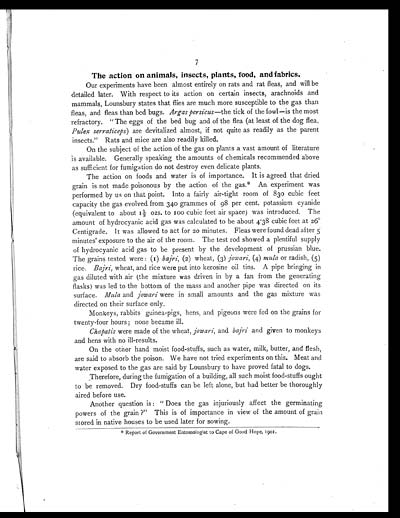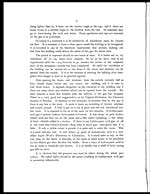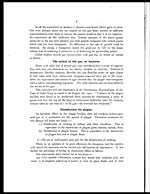Medicine - Institutions > Army health reports and medical documents > Scientific memoirs by officers of the Medical and Sanitary Departments of the Government of India > Number 38 - Preliminary report on the killing of rats and rat fleas by hydrocyanic acid gas > Preliminary report on the killing of rats and rat fleas by hydrocyanic acid gas
(15) Page 7
Download files
Individual page:
Thumbnail gallery: Grid view | List view

7
The action on animals, insects, plants, food, and fabrics.
Our experiments have been almost entirely on rats and rat fleas, and will be
detailed later. With respect to its action on certain insects, arachnoids and
mammals, Lounsbury states that flies are much more susceptible to the gas than
fleas, and fleas than bed bugs. Argas persicus—the tick of the fowl—is the most
refractory. "The eggs of the bed bug and of the flea (at least of the dog flea,
Pulex serraticeps) are devitalized almost, if not quite as readily as the parent
insects." Rats and mice are also readily killed.
On the subject of the action of the gas on plants a vast amount of literature
is available. Generally speaking the amounts of chemicals recommended above
as sufficient for fumigation do not destroy even delicate plants.
The action on foods and water is of importance. It is agreed that dried
grain is not made poisonous by the action of the gas.* An experiment was
performed by us on that point. Into a fairly air-tight room of 830 cubic feet
capacity the gas evolved from 340 grammes of 98 per cent. potassium cyanide
(equivalent to about 1 ½ ozs. to 100 cubic feet air space) was introduced. The
amount of hydrocyanic acid gas was calculated to be about 4.38 cubic feet at 26°
Centigrade. It was allowed to act for 20 minutes. Fleas were found dead after 5
minutes' exposure to the air of the room. The test rod showed a plentiful supply
of hydrocyanic acid gas to be present by the development of prussian blue.
The grains tested were: (1) bajri, (2) wheat, (3) jowari, (4) mula or radish, (5)
rice. Bajri, wheat, and rice were put into kerosine oil tins. A pipe bringing in
gas diluted with air (the mixture was driven in by a fan from the generating
flasks) was led to the bottom of the mass and another pipe was directed on its
surface. Mula and jowari were in small amounts and the gas mixture was
directed on their surface only.
Monkeys, rabbits guinea-pigs, hens, and pigeons were fed on the grains for
twenty-four hours; none became ill.
Chapatis were made of the wheat, jowari, and bajri and given to monkeys
and hens with no ill-results.
On the other hand moist food-stuffs, such as water, milk, butter, and flesh,
are said to absorb the poison. We have not tried experiments on this. Meat and
water exposed to the gas are said by Lounsbury to have proved fatal to dogs.
Therefore, during the fumigation of a building, all such moist food-stuffs ought
to be removed. Dry foodstuffs can be left alone, but had better be thoroughly
aired before use.
Another question is: "Does the gas injuriously affect the germinating
powers of the grain?" This is of importance in view of the amount of grain
stored in native houses to be used later for sowing.
*Report of Government Entomologist to Cape of Good Hope, 1901.
Set display mode to: Large image | Zoom image | Transcription
Images and transcriptions on this page, including medium image downloads, may be used under the Creative Commons Attribution 4.0 International Licence unless otherwise stated. ![]()
| Permanent URL | https://digital.nls.uk/75033592 |
|---|
| Shelfmark | IP/QB.10 |
|---|---|
| Additional NLS resources: | |




